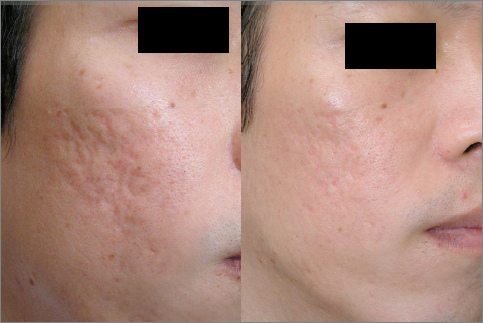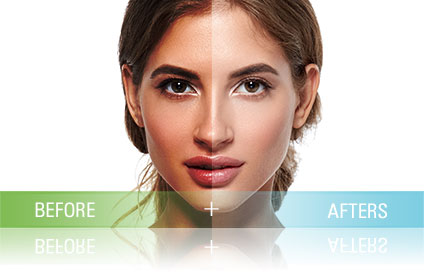Here at The Derm Institute we see many acne patients with wide variations of acne scarring. There are five common types of acne scars: ice pick acne scars, boxcar acne scars, rolling acne scars, hypertonic acne scars, and keloid acne scars. Ice pick scars are among the most common types of acne scars and are narrow scars that form pits in the skin. Boxcar scars are similar to chicken pox scars and have angular, well-defined edges that make them appear like a box. They create an indentation in the skin and are most often found on the temples or cheeks. Rolling scars create an indentation in the skin that looks like a wave, due to its wide size and shallow depth. Hypertrophic scars create a raised area on the skin within the boundary of the original wound. Unlike most acne scars, these can diminish in size and appearance over time. Keloid scars create a raised area on the skin that extends beyond the boundary of the original wound. Keloid scars are rubbery, firm and sometimes itchy. In many instances, they grow to be larger than the original inflamed blemish.
Dermal fillers are a great way to treat and potentially get rid of certain types of acne scars, being particularly effective for rolling scars and some less defined boxcar scars. They are safe and well tolerated, with great results to fill the depression associated with scars. They are excellent for volume loss caused by acne scarring.
Considering Dermal Fillers
The dose required for acne scar filling varies and is dependent on the patient’s facial anatomy, the scarring and where the patient wants to get to in terms of desired results. There are also many types of dermal fillers that you want to go through with your dermatologist. At the Derm Institute we recommend to our patients hyaluronic based fillers such as Belotero, Juvederm, or Restylane.
The dermal filler gives great results immediately and also continues to modify over the next few months. This modification and improvement occurs as a result of the technique of injection of the filler breaking up some scarred down bands, and because the product and technique stimulate collagen modification due to the stretching of the fibroblasts with the dermal filler.
How this works
A topical numbing cream is usually applied to the skin to alleviate any discomfort. Ice is always used to decrease pain and to reduce the risk of bruising. So if you are concerned of feeling any pain from this procedure, you do have relief options.
What to expect during the procedure
First the doctor and patient will have a discussion about which scars will be filled. Often patients have certain scars in particular that disturb them more than others. We want to make sure we focus on these. After the discussion of which scars will be treated, the skin will be cleaned with alcohol, ice will be applied to the area briefly before treatment, the doctor will inject using a very fine needle and then pressure with gauze will be applied.
After the doctor has filled all of the scars which seem suitable for treatment, the patient will be shown the mirror, and then the patient is offered the opportunity to point out further scars that bother them. These will then be filled.
After your treatment

Other Methods for Acne Scarring to Consider
Here at The Derm Institute we offer a 360 degree approach to acne scarring. This is why it is very important to go see a board-certified dermatologist to assess your skin type and your specific type of scarring. Punch excisions, TCA cross technique for icepick scars and fractional non-ablative laser are other great option and we often combine different treatments for the best results.
Icepick or pitted scars can be treated with the “TCA CROSS” trichloroacetic acid (TCA) and chemical reconstruction of skin scars (CROSS). TCA Cross is a skin care method in which a very high percentage of TCA is applied to the acne scar tissue only. The TCA Cross method needs to be repeated every 1-2 months so that dermal thickening and collagen production occurs inside the acne scars. After 3-9 months, you should see a great improvement in the appearance of your acne scars!
Fractional non-ablative laser offers both superior results and a little to no downtime! This laser has a hand piece that delivers light in an array of narrow, focused microbeams to create columns of coagulation within the skin. These columns initiate a natural healing process that forms new healthy tissue. This results in an improved skin appearance! Downtime is milder than other lasers, and typically resolves in 3-5 days.
Dermal Fillers show great results and improves the appearance of acne scars by lifting the depressed scars. Their effect is temporary. The results can last from between a few months to a year using fillers such as Belotero, Restylane, Juvederm, and Perlane, etc. However, with a combination of laser treatments such as the fractional non-ablative and very effective chemical peels, this can help dramatically reduce the appearance of acne scars with improvement in overall skin texture and healthy, happy skin.
Dr. Chiu and her medical team are personally involved in every treatment here at The Derm Institute. We are happy to answer any questions you may have about any of the procedures. To learn more about treatments at The Derm Institute or to schedule a free consultation, contact us by phone or email today.
. . . Shared by Dr. Chiu and The Derm Institute Team









